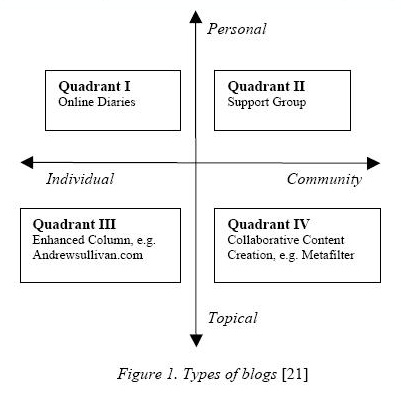Bridging the Gap: Surprisingly Worthless
Monday, October 24
3:14 PM
What is genre analysis? It's "an exercise in classification of 'typified acts of communication' based on their form and substance" (2).
There's some value in the article, including a fairly decent history of blogs:
Since mid-1999, blogging as an online activity has been increasing exponentially, enabled by the release of the first free blogging software (Pitas), and fueled by reports from the mainstream media of the grassroots power of blogs as alternative news sources, especially in the aftermath of 9/11/01 and during the U.S.-led invasion of Iraq. (1)
And the basic assertion, which the authors treat like some big revelation, that blogs were influenced by other online genres:
Our analysis suggests that blogs are neither unique nor reproduced entirely from offline genres, but rather constitute a hybrid genre that draws from multiple sources, including other Internet genres. (2)
But by far the most interesting detail as far as I was concerned was the discussion of genre categories. What kinds of blog are there?
The article attributes a three-category system to veteran metablogger Rebecca Blood: there's the notebook, the filter, and the personal journal (2).
And then there's this great system attributed to Prof. Sandeep Krishnamurthy, one of the best classification systems I've come across, which groups blogs by focus and authorship. Here's the table on page three:

In comparison to both these systems, the classification scheme used by Herring et al. is unappealing: they categorize the blogs in their survey as either personal journals, filters, k-logs (a new term for me, it seems to mean something like "knowledge weblogs"), mixed, or other. We're to take their word for it that no other types (e.g. Blood's "notebook") emerged, even though 14% of the weblogs in their survey were "mixed" or "other."
Other reasons to disregard the data here? LiveJournal and other online diary websites were excluded up front in order to diminish the significance of personal journal blogs (3), which to a stats newbie like me looks like sample bias. Blogs with less than two entries were also excluded, "so that the practices of neophyte bloggers would not bias the sample at a time when new blogs are being created daily" (3).
Here's some further qualification that articles citing this essay tend to ignore:
Thus the blogs selected for analysis were established, English language, text-based blogs. An estimated 60% of the randomly selected blogs met these combined criteria. As we were primarily interested in active blogs, we also excluded any blogs that had not been updated within the two weeks prior to data collection; this resulted in the elimination of several additional blogs. (3-4)
Also, the data for this study was collected in Spring 2003, and if my suspicions are correct, blogs created these days are probably somewhat different in their genre intent than they were two years ago. At the very least, there're more entrenched A-List bloggers nowadays.
Cite for the article:
Herring, S. C., Scheidt, L. A., Bonus, S., & Wright, E. (2004).
Bridging the gap: A genre analysis of weblogs. Proceedings of
the 37th Hawaii International Conference on System Sciences
(HICSS-37). Los Alamitos: IEEE Press.
Interesting citations to follow up on:
Crowston, K. & Williams, M. (2000). Reproduced and emergent genres of communication on the World-Wide Web. The Information Society, 16, 201-216.
Dillon, A. & Gushrowski, B.A. (2000). Genre and the Web: Is the personal home page the first uniquely digital genre? Journal of The American Society for Information Science, 51, 202-205.
Krishnamurthy, S. (2002). The Multidimensionality of Blog Conversations: The Virtual Enactment of September 11. In Maastricht, The Netherlands: Internet Research 3.0.
Comments (0)
Alles Wird Gut




